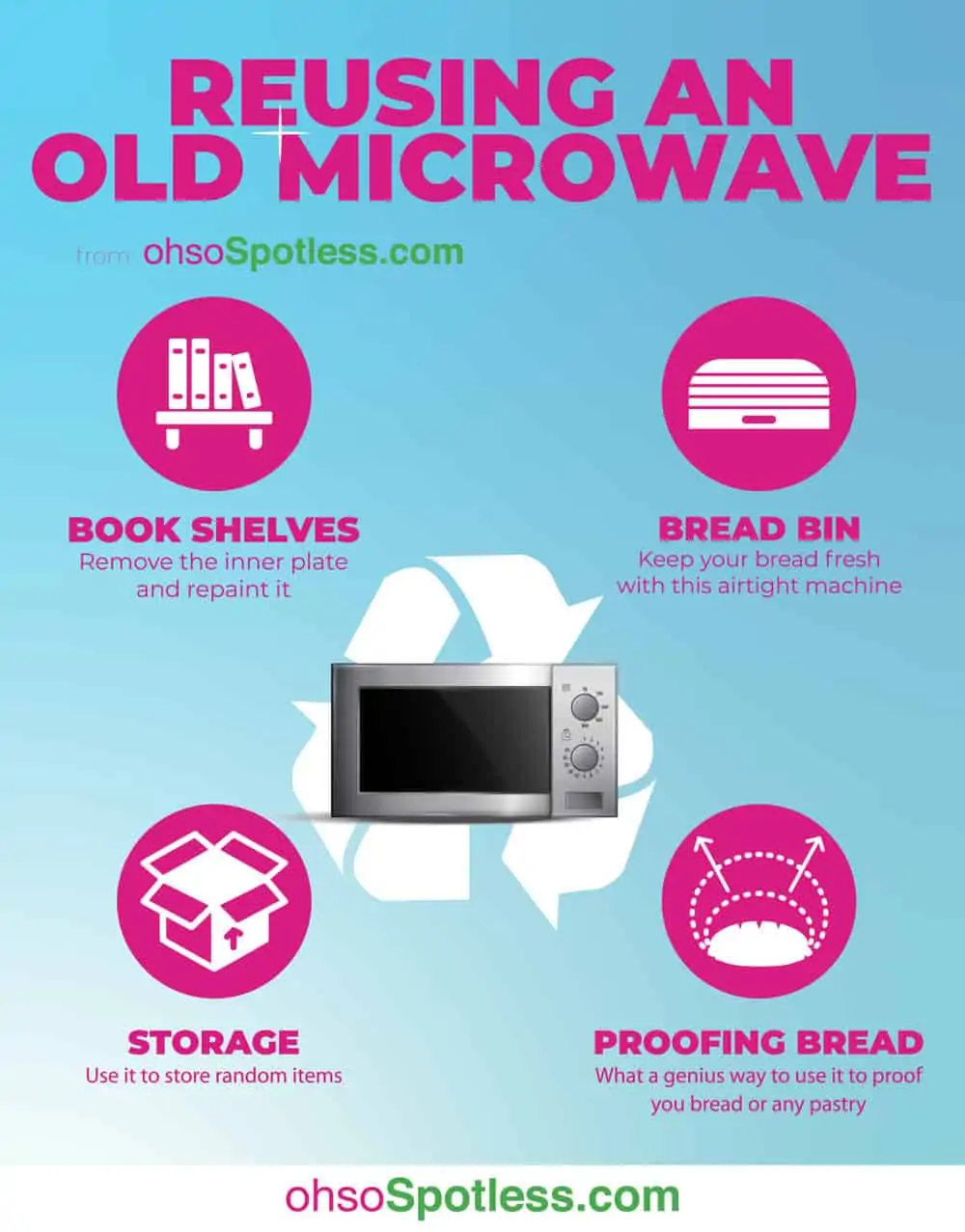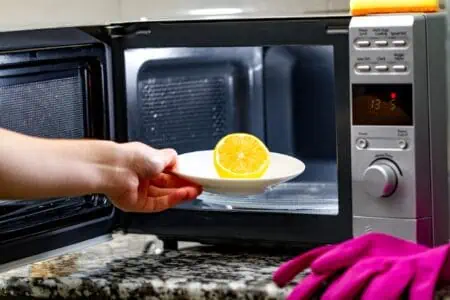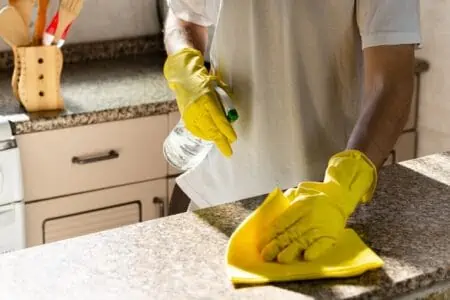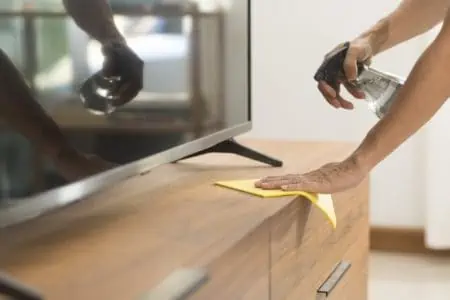Lucky you — you got a new microwave. But what on earth do you do with the old one?
We’ll walk you through how to dispose of an old microwave. There are a few different options, such as recycling it, reusing it, repurposing it, and more.
When dealing with old electrical appliances, it’s crucial to dispose of them correctly since some parts can pollute the environment. But not to worry — we’ll share the best ways to dispose of your old microwave.
Key Takeaways
- Recycle old microwaves at e-waste centers or through manufacturer take-back programs.
- Don’t throw microwaves in the trash or dumpsters, as they are considered e-waste and can harm the environment.
- Repurpose old microwaves for storage or other uses if they’re still in good condition.
- Replace your microwave if it’s over 10 years old or showing signs of malfunction, like heating issues or loud noises.
Throwing Away an Old Microwave
Perhaps you’re considering whether you can toss your old microwave in the trash or take it to the dump. This does seem like the easiest solution, but is it possible?
Can You Throw a Microwave in a Dumpster?
Since a microwave is considered e-waste, not every area allows you to toss it in the trash or bring it to a landfill site. You must check with your local area to see what their regulations are. It may be that you can organize for it to be dumped, but in most cases, it’s prohibited.
If you’re caught throwing your microwave into a dumpster where you’re not allowed, you could be fined.
Fun Fact
E-waste is electronic waste that can harm the environment due to toxic chemicals that may leach from the metals of the appliance (1). This can happen in a landfill, or once the item has been buried, so it’s best not to toss your microwave into a dumpster.
Microwave Recycling
If it can’t go in a dumpster, can it go to a recycling center? This is also a tricky answer. It’s not likely that you’ll be able to just pop your microwave in your recycling bin — but do check with your local authority.
Each part of the microwave usually has to be recycled or disposed of separately. However, just because you can’t toss it in your own recycling bin doesn’t mean that you can’t take it to a specialized e-waste recycling center.
There may be some nearby, so definitely look that up.
Other options for recycling your microwave include:
- Sending it back to the manufacturer. They may have a super handy recycling program.
- Finding a specific e-waste disposal company that will recycle and dispose of the right parts.
- Check out earth911.com, which allows you to search recycling centers near you. You may find one that accepts e-waste.
- Check with your local electronic store. Some places happily take old electronic appliances and may even give you something in exchange, such as money or store vouchers.
- If it’s not broken, you could donate it to your local charity or thrift store.
Top Tip
It’s worth checking with your manufacturer first, in our opinion, as many may offer you money back when you recycle with them.
Reusing an Old Microwave
Perhaps you don’t want to dispose of your microwave entirely. There are some fun things you could do to repurpose the microwave.
- Mini library: Some people completely turn off the microwave, remove the inner plate and repaint the outside and use it to store books!
- Storage: You could put it in a cupboard and use it to store random items. Not the same as a cute wicker basket, but it works in a pinch!
- Proofing bread: If you’re a baker, you could keep it in the kitchen and use it to proof your bread.
- Bread bin: Many people repurpose their old microwave as a bread bin. It’s a great airtight choice, so it will keep bread super fresh.
Is It Worth Fixing a Microwave?
It depends on how much the repairs will cost. If it’s going to be pricier than getting a new microwave, then definitely not.
You should also consider how long you’ve had the microwave. If it’s been a while, it may be time for a new one. Always check if it’s still covered by warranty, though, as you may not even need to spend a penny repairing or replacing the microwave.
If your microwave has any of these problems, it might be an easy fix:
- Lighting malfunction.
- Door switch issues.
- A broken touchpad.
- Broken parts such as door handle, plate, etc.
- Aesthetic impurities such as scratches or a cracked plate.
However, these problems are usually more costly and not worth fixing:
- Loud noises.
- Buzzing during operation.
- Extended cooking times.
- Magnetron issues.
How Often Should a Microwave Be Replaced?
A good microwave should last around 10 years long. However, if you use it very often, you may find that you only get about five years out of your microwave. No matter how long you’ve had it, you should replace your microwave if you notice these issues:
- It’s not heating food properly, or it’s overheating.
- There is smoke and/or burning smells.
- It’s making loud and disturbing noises.
- The door doesn’t shut or seal properly.
- The keypad is completely unresponsive.
Is an Old Microwave Dangerous?
They can be. For example, if the door doesn’t shut or seal properly, radiation can leak from the appliance (2).
The other issue with old microwaves is that they don’t work properly anymore. They may spark, smoke, or make noises which could, in theory, be a fire hazard if there is an electric problem going on.
Bottom Line
if your microwave is older than 10 years, it may be time to replace it. Just to be on the safe side.
Selling Old Microwave Parts
If your microwave is in good condition and you’re purging it because you don’t really use it, you can sell the whole thing. However, if your microwave is nearing the end of its life, you may be able to sell old microwave parts. Just note that they may not bring in a lot of cash. However, parts you may be able to sell include:
- Vent fans.
- Turntable trays.
- Keypads.
- Working magnetrons.
- Capacitors.
- Panels.
- Rotating plate.
However, we seriously recommend against doing this yourself. Taking apart a microwave is a dangerous job. These are electrical items that can actually hold electricity for a few days. Unless you know exactly what you’re doing and can confirm that the capacitor is safely discharged, you should not just take apart your microwave and sell various parts.
Instead, take it to an appliance center that can do this for you and pay you some money for the parts.
Take-Back Programs
As mentioned, some stores and manufacturers do offer to take back old and broken appliances. Some even offer an incentive. Let’s look at a few worth checking out:
- Best Buy: You can take your microwave to the Best Buy customer service counter, or you can pay a fee to have them collect it from your home. They will safely recycle the appliance, but they aren’t offering an incentive.
- LG: LG allows you to send back electronic equipment to them free of charge. However, there isn’t a clear incentive other than that.
- Panasonic and Toshiba: Panasonic and Toshiba recycle products for free as long as you drop them off at the Electronic Manufacturers Recycling Management Company, LLC.
- Samsung: Samsung partners with various recycling centers in each state to recycle their products. Check the different ones for your specific state to see if there are restrictions or incentives.
- GE: GE will take back your appliance and responsibly recycle or dispose of it. There are no incentives mentioned.
Many other stores, such as Office Depot and Lowes, have take-back programs, but they don’t currently cover microwaves.
FAQs
Responsible Recycling
When disposing of your old microwave, the best thing you can do is to take it to a responsible recycling program. Whether that’s through the manufacturer or your local authority is up to you.
You should never toss the microwave in your trash or recycling bin without checking with your local authority first. Even if you are permitted to do so, it’s not the best solution for the environment.
Where possible, donate your microwave if it’s still in good condition, as someone else could definitely benefit from it.












